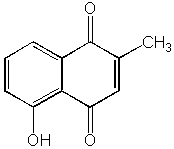
Plumbagin from Diospyros olen
Philip H. Evans1, William S. Bowers1, Marc Litaudon2 and Thierry Sevenet3
1Department of Entomology, The University
of Arizona, Tucson, Arizona, USA. Tel. 520-621-7166, ([email protected]).
2CNRS, Laboratoire des Plantes Medicinales,
Parc Forestier de Montravel, B.P. 643 Noumea, Nouvelle-Caledonie. Tel.
(687) 28 12 54, ([email protected])
3ICSN/CNRS
91198 Gif-sur-Yvette Cedex, France. Tel. (33-1) 69 82 31 03 ([email protected]).
Received: 3 February 1999 / Published: 16 April 1999

Plumbagin (5-hydroxy-2-methyl-1,4-naphthoquinone)
(CAS Reg. No. 481-42-5) was isolated from the bark of Diospyros olen
(Ebenaceae)
via
an antibiotic guided biological assay using the
bacterium Pseudomonas solanacearum.
D. olen bark, collected
in New Caledonia, was extracted with dichloromethane and components separated
by flash chromatography on silica. Plumbagin eluted with 30% diethyl ether
in hexane. Further purification by preparative silica TLC developed with
dichloromethane and by sublimation gave orange crystals. Plumbagin is a
natural product of higher plants, previously found in the family Ebenaceae
[1,2]. This is the first report of the occurrence of plumbagin in D.
olen. [3].
M.p. 72-73°. Reported 78-79°
MS (m/z,70eV): 188 (100%), 173 (25), 160 (23),
131 (38), 120 (20), 92 (21), 63 (1 8).
1H-NMR (CDCI3): 2.20 (s,
3H), 6.81 (d, 1H), 7.25 (m, 1H), 7.62 (m, 2H), 11.95 (s, 1H).
Acknowledgment: The National Science Foundation Grant BIR 9419402, National Geographic Society Grant #5426-95.
References and Notes
1. Robinson, T. Organic Constituents of Higher
Plants, 6th ed., Cordus Press, North Amherst, MA. 1991.
2. Dictionary of Natural Products v.3, p.3105.
Chapman and Hall, London, 1994.
3. We reported in this short note the isolation
and identification of plumbagin from a plant indigenous to New Caledonia.
Although identified previously from the plant "plumbago" this is the first
time it has been found in Diospyros olen. New Caledonia
was part of the ancient megacontinent "Gondwanaland" which split into parts
of present day Antarctica, Chile, New Zealand, New Caledonia, Australia,
New Guinea and other small isolated islands. While the original plant source
of this compound, plumbago, is indigenous to the old world it is still
retained in related plants after a possible 350 million years. It
is estimated that New Caledonia has been separated from Gondwanaland for
about 260 million years and allowing for the separation of the new and
old worlds of an additional 100 million years yet this same chemistry is
conserved as a very potent antibiotic which doubtless protects plants from
numerous pathogens.
Sample Availability: Aldrich Chemical Co.
©1999 MDPI. All rights reserved. Molecules website http://www.mdpi.org/molecules/